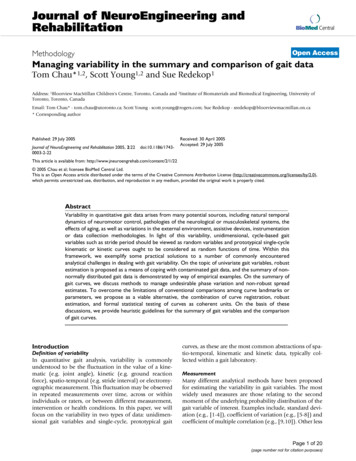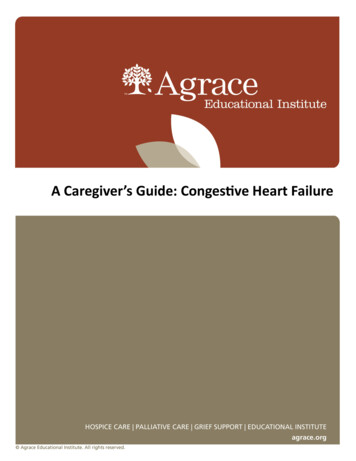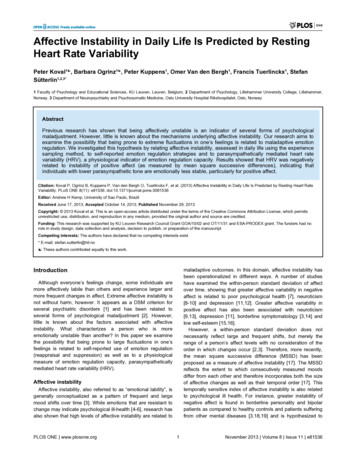
Transcription
Affective Instability in Daily Life Is Predicted by RestingHeart Rate VariabilityPeter Koval1 , Barbara Ogrinz1 , Peter Kuppens1, Omer Van den Bergh1, Francis Tuerlinckx1, StefanSütterlin1,2,3*1 Faculty of Psychology and Educational Sciences, KU Leuven, Leuven, Belgium, 2 Department of Psychology, Lillehammer University College, Lillehammer,Norway, 3 Department of Neuropsychiatry and Psychosomatic Medicine, Oslo University Hospital Rikshospitalet, Oslo, NorwayAbstractPrevious research has shown that being affectively unstable is an indicator of several forms of psychologicalmaladjustment. However, little is known about the mechanisms underlying affective instability. Our research aims toexamine the possibility that being prone to extreme fluctuations in one’s feelings is related to maladaptive emotionregulation. We investigated this hypothesis by relating affective instability, assessed in daily life using the experiencesampling method, to self-reported emotion regulation strategies and to parasympathetically mediated heart ratevariability (HRV), a physiological indicator of emotion regulation capacity. Results showed that HRV was negativelyrelated to instability of positive affect (as measured by mean square successive differences), indicating thatindividuals with lower parasympathetic tone are emotionally less stable, particularly for positive affect.Citation: Koval P, Ogrinz B, Kuppens P, Van den Bergh O, Tuerlinckx F, et al. (2013) Affective Instability in Daily Life Is Predicted by Resting Heart RateVariability. PLoS ONE 8(11): e81536. doi:10.1371/journal.pone.0081536Editor: Andrew H Kemp, University of Sao Paulo, BrazilReceived June 17, 2013; Accepted October 14, 2013; Published November 29, 2013Copyright: 2013 Koval et al. This is an open-access article distributed under the terms of the Creative Commons Attribution License, which permitsunrestricted use, distribution, and reproduction in any medium, provided the original author and source are credited.Funding: This research was supported by KU Leuven Research Council Grant GOA/10/02 and OT/11/31 and ESA-PRODEX grant. The funders had norole in study design, data collection and analysis, decision to publish, or preparation of the manuscript.Competing interests: The authors have declared that no competing interests exist.* E-mail: stefan.sutterlin@hil.no These authors contributed equally to this work.Introductionmaladaptive outcomes. In this domain, affective instability hasbeen operationalized in different ways. A number of studieshave examined the within-person standard deviation of affectover time, showing that greater affective variability in negativeaffect is related to poor psychological health [7], neuroticism[8-10] and depression [11,12]. Greater affective variability inpositive affect has also been associated with neuroticism[9,13], depression [11], borderline symptomatology [3,14] andlow self-esteem [15,16].However, a within-person standard deviation does notnecessarily reflect large and frequent shifts, but merely therange of a person’s affect levels with no consideration of theorder in which changes occur [2,3]. Therefore, more recently,the mean square successive difference (MSSD) has beenproposed as a measure of affective instability [17]. The MSSDreflects the extent to which consecutively measured moodsdiffer from each other and therefore incorporates both the sizeof affective changes as well as their temporal order [17]. Thistemporally sensitive index of affective instability is also relatedto psychological ill health. For instance, greater instability ofnegative affect is found in borderline personality and bipolarpatients as compared to healthy controls and patients sufferingfrom other mental diseases [3,18,19] and is hypothesized toAlthough everyone’s feelings change, some individuals aremore affectively labile than others and experience larger andmore frequent changes in affect. Extreme affective instability isnot without harm, however. It appears as a DSM criterion forseveral psychiatric disorders [1] and has been related toseveral forms of psychological maladjustment [2]. However,little is known about the factors associated with affectiveinstability. What characterizes a person who is moreemotionally unstable than another? In this paper we examinethe possibility that being prone to large fluctuations in one’sfeelings is related to self-reported use of emotion regulation(reappraisal and suppression) as well as to a physiologicalmeasure of emotion regulation capacity, parasympatheticallymediated heart rate variability (HRV).Affective instabilityAffective instability, also referred to as “emotional lability”, isgenerally conceptualized as a pattern of frequent and largemood shifts over time [3]. While emotions that are resistant tochange may indicate psychological ill-health [4-6], research hasalso shown that high levels of affective instability are related toPLOS ONE www.plosone.org1November 2013 Volume 8 Issue 11 e81536
Affective Instability and Heart Rate VariabilityConsequently, with the goal of reappraisal being to lessenthe emotional impact of a situation, we expect that it will beassociated with lower instability of both positive and negativeaffect (as indexed by lower MSSD). As suppression seems toprimarily affect the outward expression and less so theexperienced intensity of emotion, we do not have strongexpectations about it being related to affective instability interms of experienced affect.Heart rate variability. Resting HRV refers to the beat-tobeat variation in heart rate. Specific parameters referring to thespecific changes in heart rate [35,36] indicate the extent towhich resting HRV is determined by vagal (parasympathetic)activation. At rest, a major neural influence on heart rate isprefrontally modulated and vagally mediated tonic inhibitorycontrol [37]. During inspiration, vagal or parasympatheticactivity is reduced (leading to an increase in heart rate),whereas during expiration vagal activity is enhanced (leading toa decrease in heart rate). Consequently, higherparasympathetic activity leads to more beat-to-beat variabilityin heart rate.Obtained at rest, vagally mediated HRV is a physiologicaltrait marker of emotion regulation capacity, as the vagus nerveis connected to the same neural network (including theprefrontal cortex, amygdala, and hypothalamus) that is alsoinvolved in emotion regulation [25,38-40]. In particular, vagallymediated HRV indexes the inhibitory capacity of the prefrontalcortex that is required for regulation [40]. A growing number ofempirical studies support the assumption that resting HRV isrelated to self-regulatory strength and emotion regulation[41-44]. From a developmental perspective, increases in vagaltone during early adolescence are related to fewer selfreported problems with emotion regulation [45]. In contrast, lowHRV is related to expected outcomes of emotion regulationdeficiency: depression, anxiety, hostility and a tonic negativemood [46,47]. Similarly, patients suffering from bipolar orborderline personality disorder, both characterized by affectiveinstability, are also marked by low vagally mediated HRV[48-50]. Indeed, lower vagal activation (measured asrespiratory sinus arrhythmia) has been related to emotionaldysregulation in borderline patients, as indicated by morefrequent and more intense negative emotions [51]. Combined,these findings suggest that HRV is linked to the capacity toinhibit one’s emotional responses and to avoid excessiveemotional responding [25,40]. Consequently, we expect vagallymediated HRV to be negatively related to affective instability.While most of the studies discussed above focused onnegative affective functioning, recent research suggests thathigh vagally mediated HRV may be particularly associated withpositive emotionality [52-54]. Thus, in our study we extendupon previous findings by examining whether vagally mediatedHRV is related to instability of both positive and negative affectin daily life.play a role in several other mood disorders [2]. Amongadolescents, instability of positive and negative affect has alsobeen associated with symptoms of anxiety and depression aswell as with aggressive behavior [20].As a result, some investigators have argued that greateraffective instability reflects “dysregulation of affect” [21,22].While affect regulation can in principle be in any direction,people most often employ it to down-regulate overly intenseexperiences [10]. When such regulatory efforts are ineffective,an individual will be less able to control large affective shiftsand fluctuations, which could result in higher levels ofinstability. Indeed, the affect dysregulation assumed to underliethe abovementioned disorders is thought to give rise to largermood swings and reactivity, which in turn may manifestthemselves as increased affective instability [2,23]. However,impaired or ineffective emotion regulation is not only a featureof psychopathology, but is also associated with normalvariation in personality and well-being [24]. Thus, an importantfirst step is to investigate how emotion regulation relates toaffective instability in a non-clinical sample. While there isample evidence supporting the notion that deficiencies inemotion regulation are related to altered emotional responding[10,25-27], less is known about how emotion regulation isdirectly associated with affective instability. Our goal in thepresent study was to address this fundamental question.Emotion regulationEmotion regulation refers to all processes – automatic orcontrolled, conscious or unconscious – that may increase,maintain or decrease a person’s emotional state [28]. Emotionregulation is a multifaceted concept that can be indexed byboth subjective and objective measures. On a subjective level,people can be asked to report which strategies they use toregulate their emotions. A prominent example is the frameworkdeveloped by Gross and John [24] that distinguishes betweenseveral emotion regulation strategies, of which reappraisal andsuppression are the most widely studied. On an objective level,besides behavioral indicators of emotion regulation [29], recentresearch has suggested a biological marker of emotionregulation capacity, namely heart rate variability [25].Self-reported emotion regulation. Reappraisal is definedas a cognitive reevaluation of the emotion-eliciting situation inorder to modify its impact [24]. Suppression consists ofinhibiting the behavioral expression of one’s emotions [24].In terms of their consequences for experienced affect,reappraisal and suppression seem to be rather different. Byand large, reappraisal is associated with beneficialconsequences, such as lower levels of negative emotions andhigher levels of positive emotions, well-being, and socialrelationship quality [24,30,31]. Suppression, on the other hand,by definition decreases the extent to which emotions areovertly expressed, but this does not seem to come with anassociated change in experienced affect. Indeed, research hasshown that when people suppress the expression of theiremotions, their affective experience remains relativelyunaltered. If anything, suppression seems to enhance negativeemotions [24,32] and stress [33,34].PLOS ONE www.plosone.orgOverview of the current studyThis study investigated how affective instability is related toself-reported use of emotion regulation strategies andparasympathetically mediated HRV. We measured bothpositive and negative affective instability using the experience2November 2013 Volume 8 Issue 11 e81536
Affective Instability and Heart Rate VariabilityMaterials and proceduresampling method (ESM) [55], which provided repeatedassessments of people’s affective experiences as theynaturally occurred in daily life. ESM maximizes ecologicalvalidity and overcomes the memory biases associated withretrospective self-reports [56]. We used the MSSD as an indexof affective instability [17]. Self-reported use of reappraisal andsuppression were assessed on the first day of the study. Wemeasured heart rate at the beginning, middle and end of thestudy. Vagally mediated HRV was quantified using twomeasures: a time domain measure and a frequency domainmeasure (see below for details). We used multilevel modelingto examine how these self-reported and physiological indices ofemotion regulation were related to affective instability in dailylife. Based on the previously described theoretical andempirical literature, we hypothesized that reappraisal andvagally mediated HRV would be negatively related to affectiveinstability.The study lasted for eight consecutive days. On the morningof the first day, participants came to the laboratory for a heartrate measurement, to complete the emotion regulationquestionnaire, and to receive instructions and materials for theexperience sampling. For the following seven days, participantscarried a Palm Tungsten E2 palmtop computer and reported ontheir feelings in daily life. Participants returned for a second labsession during the experience sampling week, which includedanother heart rate measurement. On the eighth day,participants attended a final lab session to complete a numberof lab tasks, including a third heart rate assessment.Participants then returned their palmtops, were debriefed andfinancially compensated.Heart rate assessment. To ensure a high trait componentin our indices of vagally mediated HRV, we obtained repeatedlymeasured heart rate in identical settings [60].Three restingheart rate measurements were obtained for each participant:the first and third occurred on Days 1 and 8 of the study,respectively. The second measurement was obtained on Day4, 5 or 6 of the study, depending on each participant’savailability. This ensured that no two heart rate measurementsoccurred on consecutive days. During each heart rateassessment, participants were seated in individual cubicles andwere instructed to sit quietly and relax. Heart rate (interbeatintervals) was assessed at rest for 10 minutes at a samplingrate of 1000 Hz using a Polar RS800CX (Polar Electro Oy,Kempele, Finland) [61,62]. All participants were asked torefrain from alcohol for 12 hours and from caffeine, smokingand physical exercise for two hours before each measurement.Self-reported emotion regulation. Participants completedthe 10-item Emotion Regulation Questionnaire [24], whichconsists of a 6-item reappraisal subscale (α .69) and a 4-itemsuppression subscale (α .82).Experience sampling. Participants received the palmtop(programmed using a modified version of the ExperienceSampling Program) [63] to be used as an electronic diary oftheir feelings for the following week. Throughout the sevendays of experience sampling, the palmtop promptedparticipants to report their feelings 10 times a day according toa stratified random interval scheme (i.e., the day was dividedinto 10 equal intervals with one prompt programmed to occurrandomly within each interval). At each sampling moment,participants were asked to rate their current feelings using sixadjectives (happy, relaxed, angry, sad, depressed, anxious) ona scale from 0 to 100 using a continuous slider (0 not at all;100 very). The specific emotion items were chosen in orderto reflect all quadrants of the circumplex model of affect [64].Positive affect (PA) and negative affect (NA) scales werecalculated by averaging the positive and negative itemsrespectively. Multilevel reliability analyses indicated that the NAscale had reliability of .66 and the PA scale had a reliability of .63 (these are equivalent to Cronbach’s alphas in a multilevelcontext) [65]. Compliance with the experience samplingprocedure was very good: on average participants completed91.27% of scheduled beeps (SD 6.32%, range 67 - 100%).MethodsEthics statementThis study was approved by the ethics committee of theFaculty of Psychology and Educational Sciences, KU Leuvenand all participants provided written informed consent.ParticipantsOne hundred undergraduates were recruited to participate aspart of a larger study. Participants were selected from an initialsample of 439 undergraduates to represent a wide rangedepressive symptom levels, based on pre-screening with theCentre for Epidemiologic Studies Depression scale [57] (CESD, range 0 – 50, M 19.27, SD 12.53). Using a stratifiedsampling approach [58], approximately equal numbers ofparticipants were recruited from the entire CES-D prescreening range to maximize variability otherwise lacking in atypical student sample. At the time of pre-screening, 55participants had CES-D scores 16, a clinical cutoff proposedby Radloff [57], and 32 participants had CES-D scores 27, amore conservative clinical cut-off proposed by Gotlib,Lewinsohn, and Seeley [59].One participant withdrew early, four were excluded due tomissing ESM data (three participants with equipmentmalfunction and one participant showing poor compliance withmore than 40% missing data) and 12 were excluded due topoor quality heart rate data (see below), leaving a final sampleof 83 participants (52 women) ranging in age from 18 to 24years (M 19.02, SD 1.28). Participants excluded from dataanalyses did not differ from the rest of the sample on age, sex,depressive symptoms, self-reported use of reappraisal andsuppression, and either mean levels or instability of positiveand negative affect (all ps .17). Individuals suffering fromcardiovascular disease and/or taking medication affecting thecardiovascular or central nervous systems were excludedduring recruitment. The data reported here are drawn from alarger study for which participants were compensated with 70.PLOS ONE www.plosone.org3November 2013 Volume 8 Issue 11 e81536
Affective Instability and Heart Rate VariabilityData analysisgeneric symbol ERj ). We first ran unconditional models with noLevel-2 predictors. The fixed effects estimates from theunconditional models represent average levels of (logtransformed) instability across the sample. For PA, these wereB 4.33, SE 0.07, p .001, and for NA: B 2.42, SE 0.15,p .001. Random effects estimates from these modelsindicated significant amounts of between-person variability inlevels of instability for both PA (SD 0.57, p .001) and NA(SD 1.33, p .001). In our main analyses, we modeled thisbetween-person variability in PA and NA instability as afunction of emotion regulation. Thus, the Level 2 slope (γ01)represents the association between each index of emotionregulation and affective instability. PA and NA instability weremodeled in separate analyses. The model equations were asfollows:Heart rate variability. Sequential interbeat intervals weredownloaded using the software Polar Pro Trainer 5. Thefollowing pre-processing and analyses were conducted by thelast author to obtain HRV scores for each participant, beforethe main analyses relating vagally mediated HRV to affectiveinstability were conducted by the two first authors: All signalswere visually inspected and 12 participants were discardedfrom the database due to equipment failure on one or more ofthe heart rate measurements. HRV analysis was performedusing the ARTiiFACT software [66]. First, a five minute period(minutes 3 to 8) was selected from the 10-minute signal toensure the selection of a period of optimal relaxation and toexclude setting-related disturbances (starting the recording,experimenter leaving or entering the room, etc.). Then,measurement artifacts were identified by applying a criterionthreshold that was calculated for each individual based onhis/her heart rate and distribution of interbeat interval lengths.This distribution-based definition of thresholds markingmeasurement artifacts is considered the most appropriate andprecise identification algorithm as described by Berntson et al.[67,68]. Erroneous beats were deleted and substituted bymeans of cubic spline interpolation of neighboring intervals. Weextracted two indices of vagally mediated HRV usingARTiiFACT: the root Mean Square Successive Difference(rMSSD), a time domain measure, and the High Frequencycomponent (HF, 0.15-0.40 Hz), a frequency domain measure.Both measures reflect vagally mediated parasympatheticinfluences on the heart [36,60,69] and are highly correlated[70-73]. However, rMSSD appears to also capture sympatheticactivation [71]. For each HRV index, we took the mean of eachparticipant’s three measurement occasions to maximize theproportion of the trait component and minimize statedependent influences on vagally mediated HRV [60].Preprocessing of affective data. Analyzing MSSD in amultilevel model requires some preprocessing of the data. Ouranalysis focused on the time series of squared successivedifferences (denoted as SSDij where the first index refers toperson i and the second to measurement j), in line with therecommendations of [17]. The SSDij’s were calculatedseparately for positive and negative affect. To remove eveningto morning differences, we excluded difference scoresindicating mood changes between days. In addition, SSDij waslog transformed to adjust for skewness of the distribution (thezero values of SSDij were replaced with half of smallest nonzero value to allow for log transformation). Skewness values forthe SSD before log-transformation were 3.47 and 5.29 for PAand NA, respectively. After log transformation, skewnessvalues decreased to -0.97 and -0.44 for PA and NA,respectively.Statistical model.The nested structure of the data(observations nested within participants) necessitates amultilevel regression approach [74]. Following Jahng et al. [17],we modeled the (log transformed) within-person squaredsuccessive differences of affect (lnSSDAffectij) using amultilevel random intercept model in which the Level 1 randomintercept (β0j) was predicted by vagally mediated HRV,reappraisal or suppression at Level 2 (denoted below by thePLOS ONE www.plosone.orgLevel-1: ln SSDA f f ecti j β0 j ri jLevel-2: β0 j γ 00 γ01 ER j μ0 jwhere ri j 0, σ2r and μ0 j 0, σ2μ0When assessing affective fluctuations, several researchershave underlined the importance of controlling for mean levelsof affect to resolve the issue of linear dependencies betweenvariability scores and the mean [2,75]. Therefore, in a secondstep of each model, we controlled for mean level of PA or NAat Level 2, such that the Level 2 equation became:Level-2: β0 j γ 00 γ01 ER j γ02 Mean A f f ect j μ0 jResultsTable 1 displays descriptive statistics and Pearsoncorrelations among all measures. Mean levels of PA and NAwere negatively correlated, whereas instability of PA and NAwere positively associated. NA mean level correlated positivelywith both PA and NA instability. In contrast, PA mean level wasnegatively associated with PA and NA instability, althoughthere was only conclusive evidence for the latter (p .05). Thetwo HRV indices were strongly positively correlated, howeverneither rMSSD nor HF was related to reappraisal orsuppression. Finally, self-reported use of reappraisal andsuppression were also unrelated.Our main analyses consisted of eight multilevel modelspredicting PA or NA instability from each measure of emotionregulation (see model equations above).Associations between emotion regulation and PAinstabilityModels 1 and 2 examined how PA instability was related toself-reported reappraisal and suppression, respectively. Asshown in Table 2, neither reappraisal nor suppression wererelated to PA instability. After controlling for mean levels of PAat Step 2 of each model, there was no evidence forassociations between PA instability and either reappraisal orsuppression (see Table 2). In Models 3 and 4, we examinedthe associations between each index of vagally mediated HRV4November 2013 Volume 8 Issue 11 e81536
Affective Instability and Heart Rate VariabilityTable 2. Results of Multilevel Models Predicting Instability(MSSD) of Positive Affect from Self-Reported andPhysiological Indices of Emotion Regulation.Table 1. Descriptive Statistics and Correlations among allStudy Variables.1.1. PA meanlevel2. NA meanlevel3. PAinstability4. NAinstability5. rMSSD2.3.4.5.6.7.1.00-.65** 1.00-.19.22*MeanSD57.1512.7716.061.00-.40** .67** .48**397.20 202.031.00-.31** -.151.0038.416. HF.05.04-.30** -.16.86** 1.00633.77 542.367. 04.04-.02-.08-.111.00 4.39.033.03pB (SE)pIntercept (PA MSSD)γ004.33 (0.07) .0014.32 (0.07) .001Reappraisalγ01-0.02 (0.07).753-0.02 (0.07).790PA mean levelγ02――-0.14 (0.09).134Intercept (PA MSSD)γ004.32 (0.07) .0014.32 (0.07) .001Suppressionγ010.04 (0.06).4750.04 (0.06).461PA mean levelγ02――-0.14 (0.09).136Model 2139.02 114.43.03Step 2Parameter B (SE)Model 111.00.02(HRV)Step 1Predictor15.47Model 30.841.29Intercept (PA MSSD)γ004.33 (0.07) .0014.33 (0.07) .001rMSSD (HRV)γ01-0.18 (0.07).010-0.18 (0.06).009PA mean levelγ02――-0.13 (0.09).121Note. N 83. Means and SDs for PA and NA instability are based on raw meanModel 4square successive differences rather than log transformed values. PA positiveIntercept (PA MSSD)γ004.32 (0.07) .0014.32 (0.07) .001affect; NA negative affect; rMSSD root mean square successive difference; HFHFγ01-0.17 (0.06).006-0.16 (0.06).008 high frequency component expressed in absolute units; HRV heart ratePA mean levelγ02――-0.13 (0.09).144variability.In Step 2 mean affect was controlled for.* p .05, ** p .01.doi: 10.1371/journal.pone.0081536.t002doi: 10.1371/journal.pone.0081536.t001reappraisal or suppression either before or after controlling forNA mean level (see Models 5 and 6 in Table 3). Finally, Models7 and 8 tested associations between each index of vagallymediated HRV and NA instability. We found no evidence for anassociation between NA instability and either rMSSD or HF atStep 1 of Models 7 and 8. However, after controlling for meanNA (Step 2), there was some evidence for an associationbetween each index of vagally mediated HRV and NAinstability (see Table 3). When we repeated Models 7 and 8excluding the outliers on each index of vagally mediated HRV(as defined above), these results replicated: no (or weak)evidence that either rMSSD (β -0.18, SE 0.18, p .308) orHF (β -0.37, SE 0.19, p .061) were related to NAinstability before controlling for mean level of NA. However,after controlling for NA mean level, there was evidence for bothassociations (rMSSD: β -0.25, SE 0.10, p .017; HF: β -0.32, SE 0.12, p .009).and PA instability. In contrast to results for the self-reportedemotion regulation, there was conclusive evidence that boththe rMSSD and HF indices of HRV were negatively associatedwith PA instability (see Table 2). This evidence remained aftercontrolling for mean level of PA (see Step 2 in Models 3 and 4).Figures 1 and 2 plot the associations between PA instabilitywith the rMSSD and HF indices of vagally mediated HRV,respectively. Figure 1 shows that one participant had anrMSSD value more than 3 SDs above the sample mean andreference values representative for the general propulation [76]and can therefore be considered an outlier. Similarly, Figure 2shows that two participants were outliers on the HF index. Toensure that our results were not unduly influenced by theseoutliers, we repeated Model 3 excluding the individual with anextreme score on rMSSD: There was still evidence, althoughsomewhat weaker, for an association between rMSSD and PAinstability both before (β -0.16, SE 0.08, p .049) and aftercontrolling for PA mean level (β -0.16, SE 0.08, p .044).Similarly, we re-ran Model 4 excluding the two participants whowere outliers on HF: Again, there was still evidence, althoughsomewhat weaker, for an association between HF and PAinstability both before (β -0.17, SE 0.08, p .045) and aftercontrolling for PA mean level (β -0.16, SE 0.09, p .061).Ancillary analyses relating other measures of affectdynamicsWe also examined how emotion regulation was related totwo other measures of affect dynamics, the within-personstandard deviation and autocorrelation, which are subcomponents of affective instability [17]. We found no statisticalevidence for associations between self-reported reappraisal orsuppression and either the standard deviation orautocorrelation of either PA or NA (rs .15 , ps .18).Similarly, there was no evidence that either of the two HRVindices was related to the autocorrelation of PA or NA, or to thestandard deviation of NA (rs .13 , ps .26). However, therewas some weak evidence that the two HRV indices wereAssociations between emotion regulation and NAinstabilityModels 5 and 6 examined associations between NAinstability and self-reported reappraisal and suppression,respectively. Similar to the results for PA, there was noevidence that NA instability was associated with self-reportedPLOS ONE www.plosone.org5November 2013 Volume 8 Issue 11 e81536
Affective Instability and Heart Rate VariabilityFigure 1. Standardized PA instability scores plotted against standardized HRV (rMSSD) values. Individual PA instabilityvalues are person-specific intercepts obtained from an intercept-only multilevel model with log-transformed PA squared successivedifferences as the outcome. Linear fit line shown is based on all observations.doi: 10.1371/journal.pone.0081536.g001relationship between vagally mediated HRV and affectiveinstability cannot be attributed to tonic mood differences. Asprevious research [46,47,53] has shown that vagally mediatedHRV is related to such mean levels of affect, it may beimportant to control for individual mood differences veinterpretation of analyses controlling for mean levels of affect isless straightforward. We therefore advise caution wheninterpreting the results regarding instability of NA.Our failure to find a relationship between self-reported use ofemotion regulation and affective instability might be due to howreappraisal an
Affective Instability in Daily Life Is Predicted by Resting Heart Rate Variability Peter Koval 1 , Barbara Ogrinz , Peter Kuppens, Omer Van den Bergh, Francis Tuerlinckx1, Stefan Sütterlin1,2,3* 1 Faculty of Psychology and Educational Sciences, KU Leuven, Leuven, Belgium, 2 Department of Psychology, Lillehammer University College, Lillehammer,

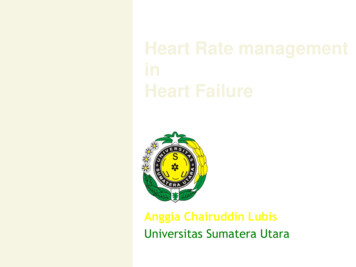

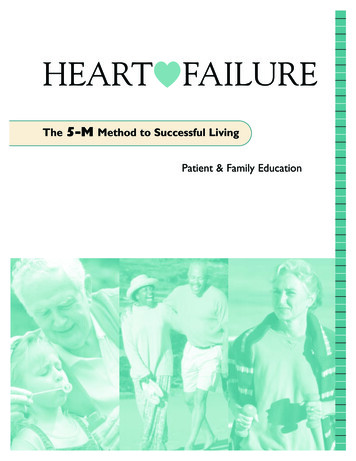
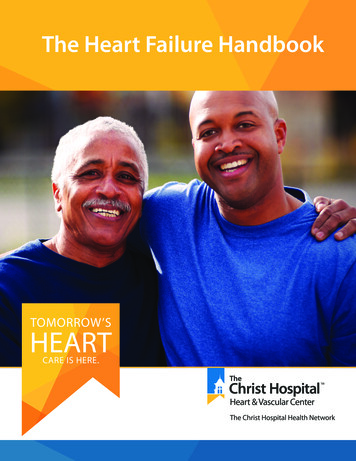
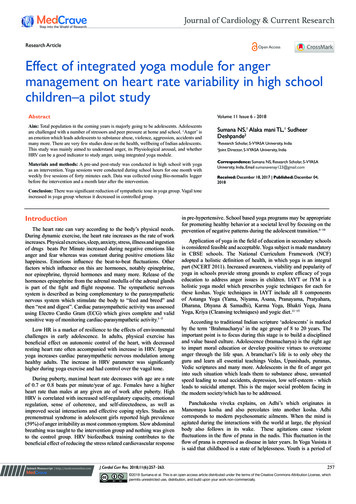

![High Variability [Pronunciation] Training (HVPT)](/img/28/2018thomson-hvpt.jpg)
